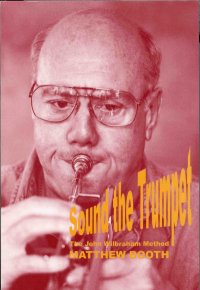| O.J.'s Trumpet Page | Articles and reviews |

Facts:
Author: Matthew Booth
Publisher: Stainer & Bell Ltd
Year published: 2000
ISBN: 0 85249 860 8
Number of pages: 70
Price: GBP £8.95
Content:
1. The instrument
2. Learning to Blow
3. Developing Your Playing
4. Good Practice
5. A Note on Transposition
+ Acknowledgement, Foreword (by Michael Laird), Introduction and Appendix A & B.
John Wilbraham died in 1998 only 53
years old. He was well known as both principal trumpet with leading
London
orchestras and as a soloist with many recordings. But his greatest
legacy
is perhaps as a teacher: "John’s approach to teaching was highly
personal
and at its heart were the basic principles of technique, how to blow a
trumpet and the importance of a lyrical trumpet sound. He could not
only
inspire pupils to try to match his own gloriously rich trumpet tones,
but
also give them the skills to do it. The technique, once mastered,
enabled
the Wilbraham student to achieve his or her full potential, and to be
self-healing
if problems arose later on in their career. He prepared his pupils to
be
physically equipped as players and mentally equipped as musicians to
handle
life in the music profession." *)
One of his students, Matthew Booth**), worked with Wilbraham and encapsulated his ideas on trumpet playing. This is a textbook, not an exercise book, but there are some nice exercises and several good pictures and illustrations. The diaphragm illustration is a bit confusing, but one can understand the meaning from the text.
The best part in the book is in my opinion chapter 2. Learning to Blow, the section Forming the Embouchure and Sound Production. The explanation is very clear, with good illustrations.
"Most early playing problems stem from this practice of starting to learn very low in the instrument's range, and they are often found together with incorrect mouthpiece placement on a poorly formed embouchure." (from the Introduction).
By establishing the middle C (third space) as the central note, there will be less problems for the player, both mentally (only one octave to high C - not two) and physically (a firmer setting). This philosophy can be found in the teaching of other trumpet professors, like Armando Ghitalla (see ITG Journal - May, 1997 "Interview with Armando Ghitalla") or Bo Nilsson (see Brass Bulletin No. 113).
Also the section Putting Theory into Practice, where a Concone etude is analyzed, is excellent.
This book will be of great help to beginners, but experienced players will also find it useful. The book is "a must" for those teaching beginners, but as Michael Laird says in the foreword: "I just wish I had owned a copy 35 years ago - it would have saved me a lot of time and heartache!"
I was really impressed with Stainer & Bell, I ordered the book online and 3 days later I had it.
A great little book - Recommended!
**) In an obitary
in Daily Telegraph, 16th April 1998, Booth says: "Earlier
this
year, I wrote an account of John's teaching method, and since then we
had
spent many hours finalising (in truth, him telling me) the text."